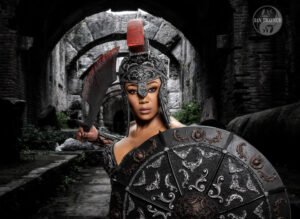Photo shoot for make up artist (MUA)
Make up artists (MUAs) need good professional portfolios to showcase their work. This post is about a photo shoot I did for a local make up artist, Alice Edwards.
Alice is a freelance make up artist with 2 years of commercial experience. Currently she is studying for a Bachelors Degree in Production Arts Hair and Make Up at Kingston College, in Kingston upon Thames, Surrey. Alice asked me to take photographs to document a specific make up look she was doing for a college assessment. I have worked with Alice before, and was happy to oblige. My photographs provide a record of her work, and will be included in her professional make up artist portfolio.
I am only including a few of my photographs from this photo shoot in this blog post.
Alice arranged for model Gina Godfrey to help by providing her face.
Alice and I have both worked with Gina before, so we knew we were getting a model who is reliable. In my opinion “reliability” is one of the most important skills a model can possess.
Gina is also blessed with very good skin, and beautiful eyes. So I sort of think Alice was stacking the odds in her favour!
I wanted to provide photographic variety
Taking photographs for the make up artist
My main priority was to make a high quality record of Alice’s skill as a make up artist, that she could use in her portfolio. We would only be taking head shots, so we didn’t have to think about using other props, and a plain background would be suitable.
I needed to photograph the make up in detail, so I had to light my model, Gina, accordingly.
Taking photographs for Gina’s modelling portfolio
But I also wanted to provide some photographic variety for Gina’s modelling portfolio. We wouldn’t have time to make major changes to lighting or location, so I set up some lights that would provide adaptability.
Travelling light (weight) with minimal kit
I also wanted to travel light, so may main kit consisted of two speedlights, a couple of lighting modifiers from Damian McGillicuddy, and the Olympus EM-1 mark2 camera fitted with a 45mm F1.8 lens. Because the Olympus has a micro four thirds chip, a 45mm lens is the equivalent of a 90mm lens on a camera that has a full frame sensor (such as my Nikons). In other words, this prime lens is an ideal lens for flattering portraits. It is also extremely sharp. Incidentally, this is the sharpest lens I have ever used… and Olympus has just brought out a new, better, 45mm F1.2 prime lens. Which costs nearly 5 times as much. Hmmm.
Photographic variety was achieved simply by changing the positions of the lights, and particularly the amount of light cast on the background. The background was a pale grey area of wall. (In fact it was a writing board of some kind I believe). But one can make this appear totally white if it is brightly lit. All the photos I took used the same background. The background appears to be darker in some images because I was controlling how much light fell on it.

I used a 21 inch DMLS modifier to provide the main (or key) light on the model, Gina Godfrey. You can just see it (in soft box configuration) on the left in the photo.
I also used a foldable Lastolite reflector to empirically control the brightness (and direction) of the fill light. I used a human light stand to hold this (her name is Alice Edwards).
The resulting images (of which only a few are shown here) provide a series of images that show Alice’s make up, and some additional images that are not useful for showing make up, but provide the model, Gina Godfrey, more variety for her modelling portfolio.
Using Photoshop to give a natural look – detail
I think even the general public is aware that models can be “over photoshopped” so they end up looking, er… “different”, and even unnatural. My personal preference is to retain a natural look that is flattering, while removing temporary blemishes.
You can still see every pore on her skin, and every fine hair on the model’s face. And she still looks gorgeous. Just naturally gorgeous.
As a photographer, I was particularly pleased that you can’t see Gina’s own eyelashes. That is to say they are completely hidden by the artificial eyelashes that Alice has added.
Sometimes, when artificial eyelashes have been added, you can see the model’s own eyelashes underneath. They often don’t look nice, and have to be removed in post production. For example they may be a different colour, and more curly, than the artificial eyelashes. So a second set of eyelashes, which are a different shape and colour from the main eyelashes – well, it doesn’t look good! I am not a make up artist, and I don’t know why sometimes you can see them, and sometimes you can’t. But you usually have to look closely to notice them.









